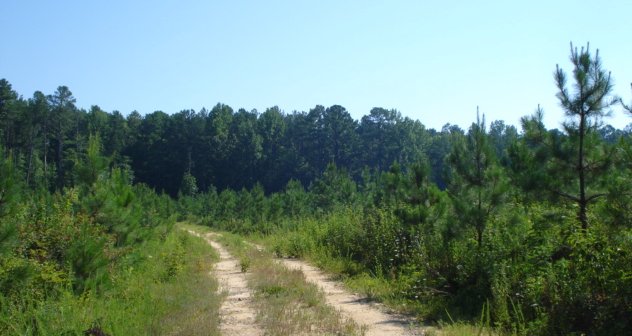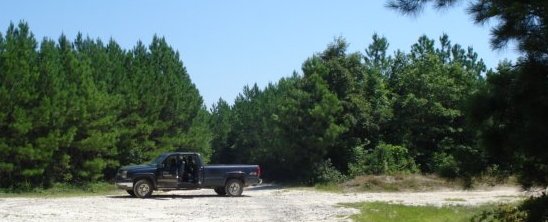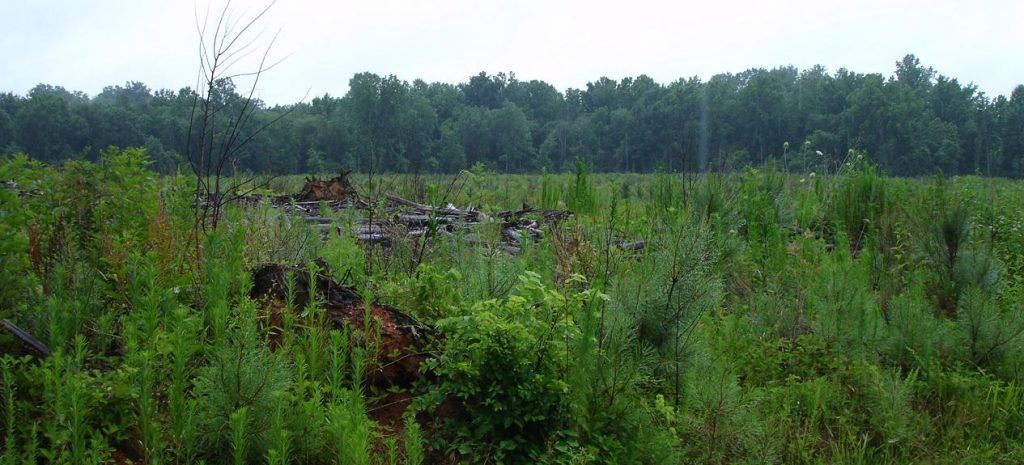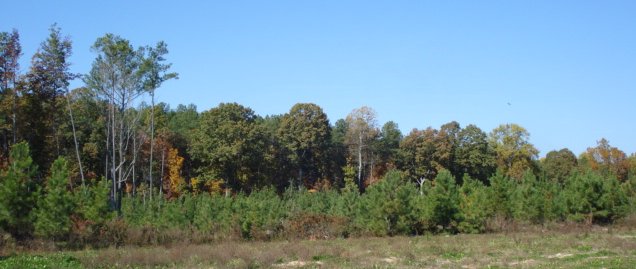I wrote this article about investing in forest lands for the next issue of “Virginia Forests.” It is based on a posting I made a couple months ago, so it should look familiar. Below are five-year-old pines.

We own lots of things during our lifetimes but we form special bonds with land; it is our connection to the earth and our legacy for future. There is no surprise that people have deep feelings for land that has been in their families for generations, but it is astonishing how fast the same sorts of connections form with adopted land.
I have loved forests and wanted to have my own part as long as I can remember, but owning a forest is not something you can easily do. Many forest owners inherit their land. Others have long connections with the forestry community. I was completely new. I would have to think about it long and hard. I thought about it for more than twenty years. I couldn’t afford to buy a forest as a luxury. My forest had to be an investment that would at least break even, so I started to study the economics of forestry. I was surprised and encouraged to learn that forestry is an excellent, if illiquid, investment. According to “Forbes” magazine, timber investments from 1990 – 2007 timber produced a compounded annual return of 12.88%. You can’t beat that if, and only if, you have the time and ability to wait for nature to take its course. There are several ways to invest in forestry.
Below are twelve-year-old pines. They are growing very well, but are a little thick. We will probably thin early – in two or three years.

Many people who invest in forestry do so through Timber Investment Management Organizations (TIMOs). That option didn’t appeal to me. That makes forestry just another investment. My logic was the reverse. I wanted to own a forest and I needed to justify it as an investment, not the other way around. I wanted my forest that I could stand on and manage. After investigating the economics, I decided that I felt secure enough in my judgment on this matter to base my retirement savings on growing trees rather on a capricious stock market.
Of course finding the right forest is harder than buying stocks or bonds. I needed to find a place close enough that I could visit but far enough from my home in Northern Virginia that I could afford the land. My research took me to Southside Virginia on the Piedmont south of Richmond. I quickly learned that successful forestry on my tract of land requires successful forestry on the land in the neighborhood. Timber is heavy and hard to transport. Unless you have enough nearby forested acres, skilled forestry contractors and mills to process the timber and sustain a forestry industry, you cannot grow trees profitably. The forests of Southside Virginia meet these requirements.

The real estate broker didn’t think I was serious when I called and he probably didn’t change his mind when I showed up at his office in Lawrenceville. He tried to steer me to small tracts of land suitable for a getaway cabin. I told him that I wanted a place for forestry – real forestry. “You would never be able to build your cabin,” he warned. This is just land good for growing trees. He smiled when I told him that is exactly what I wanted.
We looked at several tracts of well developed timberland and then told me about a recent clear cut, which was less expensive. The trees were two years old, but there was good site preparation and I could see the tops of the little pines poking above the weeds, slash & brush. I loved the potential. I also liked the streams and the mature hardwoods left near them.

Above is the land as we bought it in 2005. Below is three years later in 2008. Trees grow. The ones in the lower picture are thinned to make them more resistant to pests and improve wildlife habitat. Notice the different density compared with the twelve-year-old trees in the picture with the truck. Those are planted a little too thick, IMO, which is why we will thin early. There is disagreement re how thick pines should be planted. The latest practice is to plant thinner for the wildlife and pest benefits I mentioned, as well as the idea that a thinner forest will produce more chip-and-saw and saw timber … eventually.

The smartest thing a new landowner can do it to get to know the neighbors and make some local friends. They are the ones who protect your land … or not. Fortunately, the land I bought already had a hunt club associated with it and they were happy just to keep on doing what they had been doing. The hunt club maintains the gates and the “no trespassing” signs. In this rural area, everybody knows everybody else, so it is helpful if they know me too. Local friends are also very helpful in suggesting contractors.
Below you can see some of the diversity of the tree farm. In the front is a food plot (a little beaten down because they used it as a staging area for the thinning and biosolid applications. It will better next year.) The pine plantation is in the middle and you can see the mature hardwoods (oak, beech, tulip poplar & sweet gum) in the background. This provides a balanced habitat for wildlife. I think it just looks nicer too.

There are lots of things a forest owner needs to know and do. Fortunately, there are lots of people and organizations eager to help. One of the first things a new owner should do is become a certified tree farmer. Sustainable forestry is becoming increasingly important and the American Tree Farm System helps landowners understand and use the best practices on their own tree farms. The ATFS requires a forestry plan, which informs choices and is a key to making better decisions. It pays off. Another of the first stops is the local forester. The Virginia Department of Forestry can hook the new owner into networks of helpers and information and help fund programs benefit forests all over the state. The Virginia Forest Landowner Update is the place you can find out about events and programs for forest owners. Many of the events are free or inexpensive. I attended many field days and I learned about things like soils, pests, invasive species, better trees, taxation questions and a lot more from events available through the update. Finally, getting a good forestry consultant is a must. I hope someday to know how to do many of the forestry activities on my own (or make my kids do them), but I will never have the expert knowledge of a trained forester who works full-time on these issues.
I joined the Virginia Forestry Association and got the communication director job for the Virginia tree farm project of the ATFS. It is a great privilege and learning opportunity. My job mostly consists of writing articles for the Virginia Forests magazine four times a year and I get to write the story of the tree farmer of the year. The more successful tree farms you see, the more you understanding your own. I have never met or even heard about a tree farmer who didn’t love his forest, and everybody you meet is eager to talk about what they did on their own land and help others do good things too.
I have been happy with my forestry investment and the forestry community it opened for me. You cannot rush the trees, so I sometimes wish I had got into the business sooner and been further along. But I then I remember that I couldn’t. Besides the obvious lack of money (or more correctly mortgage credit), I didn’t have enough understanding of the forestry business. Liking trees is not enough. You need to know a lot more than I do, but I get along with a little help from my friends.
Forestry on Televison
Forestry seems to be enjoying some popularity. There are two competing logger shows on cable TV. The first was Ax Men on History Channel and now we have Extreme Loggers on Discovery and American Loggers. Of course, these programs show the most exciting, challenging and dangeous part of forestry. For me the growing and environmental aspects are most interesting, but those processes unfold slowly and prosaically. It doesn’t make good TV. They also show the forestry in big, natural forests. Tree farms are more civilized and easy to work. Nevertheless, logging can be indeed a tough job. Here are some pictures of logging machines.
Very good is the Ax Men 3D Logging Tour.
